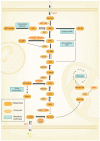Role of Glucose Metabolic Reprogramming in Breast Cancer Progression and Drug Resistance
- PMID: 37444501
- PMCID: PMC10341343
- DOI: 10.3390/cancers15133390
Role of Glucose Metabolic Reprogramming in Breast Cancer Progression and Drug Resistance
Abstract
The involvement of glucose metabolic reprogramming in breast cancer progression, metastasis, and therapy resistance has been increasingly appreciated. Studies in recent years have revealed molecular mechanisms by which glucose metabolic reprogramming regulates breast cancer. To date, despite a few metabolism-based drugs being tested in or en route to clinical trials, no drugs targeting glucose metabolism pathways have yet been approved to treat breast cancer. Here, we review the roles and mechanisms of action of glucose metabolic reprogramming in breast cancer progression and drug resistance. In addition, we summarize the currently available metabolic inhibitors targeting glucose metabolism and discuss the challenges and opportunities in targeting this pathway for breast cancer treatment.
Keywords: Warburg effect; breast cancer; drug resistance; glucose metabolism; metabolic inhibitor; metastasis; reverse Warburg effect; tumor microenvironment.
Conflict of interest statement
The authors declare no conflict of interest.
Figures



Similar articles
-
Reprogramming of glucose metabolism: The hallmark of malignant transformation and target for advanced diagnostics and treatments.Biomed Pharmacother. 2024 Sep;178:117257. doi: 10.1016/j.biopha.2024.117257. Epub 2024 Aug 12. Biomed Pharmacother. 2024. PMID: 39137648 Review.
-
Role of glucose metabolic reprogramming in colorectal cancer progression and drug resistance.Transl Oncol. 2024 Dec;50:102156. doi: 10.1016/j.tranon.2024.102156. Epub 2024 Oct 13. Transl Oncol. 2024. PMID: 39405607 Free PMC article. Review.
-
The Molecular Mechanisms behind Advanced Breast Cancer Metabolism: Warburg Effect, OXPHOS, and Calcium.Front Biosci (Landmark Ed). 2024 Mar 13;29(3):99. doi: 10.31083/j.fbl2903099. Front Biosci (Landmark Ed). 2024. PMID: 38538285 Free PMC article. Review.
-
Glutamine metabolism in breast cancer and possible therapeutic targets.Biochem Pharmacol. 2023 Apr;210:115464. doi: 10.1016/j.bcp.2023.115464. Epub 2023 Feb 26. Biochem Pharmacol. 2023. PMID: 36849062 Review.
-
Multiomics integrative analysis reveals antagonistic roles of CBX2 and CBX7 in metabolic reprogramming of breast cancer.Mol Oncol. 2021 May;15(5):1450-1465. doi: 10.1002/1878-0261.12894. Epub 2021 Mar 13. Mol Oncol. 2021. PMID: 33400401 Free PMC article.
Cited by
-
Exploiting acquired vulnerability to develop novel treatments for cholangiocarcinoma.Cancer Cell Int. 2024 Nov 5;24(1):362. doi: 10.1186/s12935-024-03548-2. Cancer Cell Int. 2024. PMID: 39501277 Free PMC article. Review.
-
Functions of Differentially Regulated miRNAs in Breast Cancer Progression: Potential Markers for Early Detection and Candidates for Therapy.Biomedicines. 2024 Mar 20;12(3):691. doi: 10.3390/biomedicines12030691. Biomedicines. 2024. PMID: 38540304 Free PMC article. Review.
-
Insights into Metabolic Reprogramming in Tumor Evolution and Therapy.Cancers (Basel). 2024 Oct 17;16(20):3513. doi: 10.3390/cancers16203513. Cancers (Basel). 2024. PMID: 39456607 Free PMC article. Review.
-
Breast Cancer Chemoresistance: Insights into the Regulatory Role of lncRNA.Int J Mol Sci. 2023 Nov 2;24(21):15897. doi: 10.3390/ijms242115897. Int J Mol Sci. 2023. PMID: 37958880 Free PMC article. Review.
-
Osteopontin: A Key Multifaceted Regulator in Tumor Progression and Immunomodulation.Biomedicines. 2024 Jul 9;12(7):1527. doi: 10.3390/biomedicines12071527. Biomedicines. 2024. PMID: 39062100 Free PMC article. Review.
References
Publication types
Grants and funding
LinkOut - more resources
Full Text Sources
Research Materials

